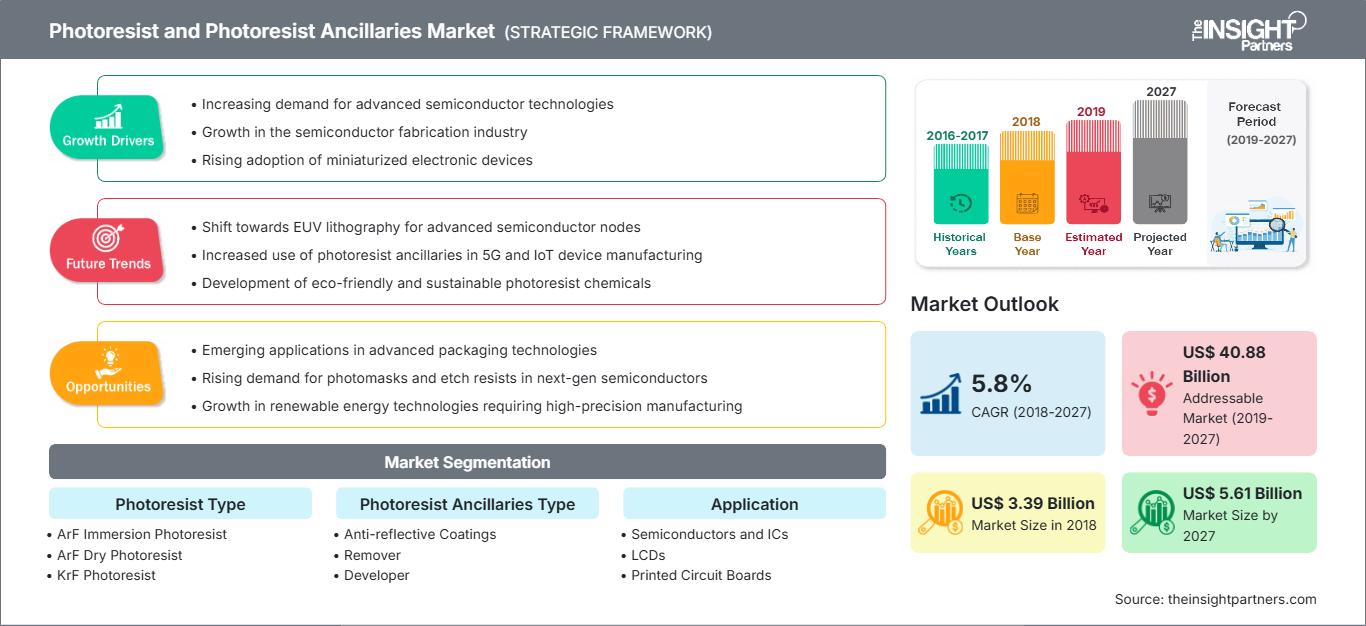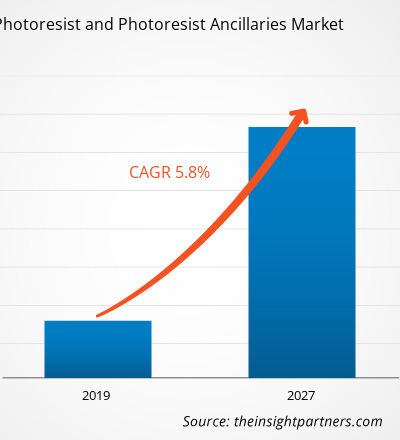Il mercato del fotoresist e dei relativi accessori è stato valutato a 3.392,97 milioni di dollari nel 2018 e si prevede che raggiungerà i 5.614,37 milioni di dollari entro il 2027; si prevede una crescita a un CAGR del 5,8% dal 2019 al 2027.
I fotoresist sono resine polimeriche fotosensibili utilizzate principalmente nella produzione di circuiti stampati, lastre di stampa, display a cristalli liquidi a schermo piatto, testine di registrazione magnetiche e sistemi microelettromeccanici (MEMS). Questi componenti fungono da materiali di mascheratura per il trasferimento delle immagini su un substrato sottostante tramite processi di incisione. Gli accessori per fotoresist sono materiali come stripper per fotoresist, rivestimenti antiriflesso, sviluppatori e prodotti per la rimozione di cordoni di bordo utilizzati insieme al fotoresist. I fotoresist e i relativi accessori vengono utilizzati nella configurazione dei cablaggi nei semiconduttori multistrato per la produzione di computer, laptop, lettori musicali, telefoni, server ed elettrodomestici. L'industria elettronica sta vivendo una crescita costante nei paesi sviluppati e in via di sviluppo. Le aziende che operano in questo settore utilizzano fotoresist e relativi accessori nella produzione di prodotti quali telefoni avanzati, sistemi informatici, televisori e apparecchiature per l'home entertainment, nonché dispositivi elettronici di controllo e monitoraggio utilizzati in numerose applicazioni industriali e scientifiche.
Si prevede che il Nord America crescerà al CAGR più elevato del 6,0% durante il periodo di previsione. Diverse aziende nazionali e internazionali hanno una solida presenza in Nord America. Le aziende stanno costantemente migliorando i processi aziendali complessivi per soddisfare al meglio la domanda dei clienti. Diverse aziende nazionali e internazionali hanno una solida presenza nella regione nordamericana. Nella regione del Nord America, gli Stati Uniti rappresentano un mercato importante per il fotoresist e i relativi accessori, seguiti da Canada e Messico.
L'epidemia di COVID-19 è iniziata a Wuhan (Cina) nel dicembre 2019 e da allora si è diffusa rapidamente in tutto il mondo. Cina, Italia, Iran, Spagna, Repubblica di Corea, Francia, Germania e Stati Uniti sono tra i paesi più colpiti in termini di casi positivi e decessi segnalati a marzo 2020. Secondo gli ultimi dati dell'OMS, si contano circa 332.930 casi confermati e 14.510 decessi totali a livello globale. L'epidemia di COVID-19 ha colpito economie e settori industriali in diversi paesi a causa di lockdown, divieti di viaggio e chiusure aziendali. L'industria chimica e dei materiali a livello globale è uno dei principali settori che ha subito gravi interruzioni, come interruzioni della catena di approvvigionamento, cancellazioni di eventi tecnologici e chiusure degli uffici a causa di questa epidemia. Ad esempio, la Cina è il polo manifatturiero globale e il principale fornitore di materie prime per vari settori. Il crollo generale del mercato dovuto al COVID-19 sta influenzando anche la crescita del mercato dei fotoresist e dei relativi accessori a causa della chiusura delle fabbriche, degli ostacoli nella catena di approvvigionamento e della recessione dell'economia mondiale.
Personalizza questo rapporto in base alle tue esigenze
Potrai personalizzare gratuitamente qualsiasi rapporto, comprese parti di questo rapporto, o analisi a livello di paese, pacchetto dati Excel, oltre a usufruire di grandi offerte e sconti per start-up e università
Mercato dei fotoresist e dei relativi accessori: Approfondimenti strategici

-
Ottieni le principali tendenze chiave del mercato di questo rapporto.Questo campione GRATUITO includerà l'analisi dei dati, che vanno dalle tendenze di mercato alle stime e alle previsioni.
Approfondimenti di mercato La crescente domanda da parte di diverse applicazioni ha favorito il mercato globale dei fotoresist e dei relativi accessori
La crescente domanda da parte di diverse applicazioni, come semiconduttori e circuiti integrati, LCD e circuiti stampati, sta trainando il mercato dei fotoresist e dei relativi accessori in tutto il mondo. Uno dei principali fattori di crescita per il mercato dei fotoresist e dei relativi accessori è il loro utilizzo nei display a schermo piatto. Poiché questi display sono più sottili, leggeri e più efficienti dal punto di vista energetico, sono preferiti rispetto ad altri display, stimolando così la crescita del mercato nei paesi sviluppati e in via di sviluppo come Stati Uniti, Regno Unito, Italia, Cina, India, Russia, Giappone, Messico e Canada. Inoltre, i fotoresist vengono utilizzati anche nella configurazione dei cablaggi nella produzione di semiconduttori multistrato, che costituisce una parte fondamentale di laptop, computer, lettori musicali, telefoni, server ed elettrodomestici. I fotoresist sono resine polimeriche fotosensibili utilizzate principalmente nella produzione di circuiti stampati, lastre di stampa, display a cristalli liquidi a schermo piatto, testine di registrazione magnetiche e sistemi microelettromeccanici (MEMS). Questi componenti fungono da materiali di mascheratura per il trasferimento delle immagini su un substrato sottostante tramite processi di incisione. Gli accessori per fotoresist sono materiali come stripper per fotoresist, rivestimenti antiriflesso, sviluppatori e prodotti per la rimozione di cordoni di bordo utilizzati insieme al fotoresist.
Approfondimenti sulle applicazioni
In base all'applicazione, il mercato dei fotoresist e dei relativi accessori è segmentato in fotoresist a immersione ArF, fotoresist a secco ArF, fotoresist KrF e fotoresist G-line e I-line. Nel 2018, il segmento dei fotoresist a immersione ArF ha rappresentato la quota maggiore del mercato globale dei fotoresist e dei relativi accessori; Tuttavia, si prevede che il segmento dei fotoresist G-line e I-line crescerà a un CAGR più elevato durante il periodo di previsione. Sono considerati un'eccellente finestra di processo che mostra uniformità della dimensione critica (CD) che consente una migliore forma del profilo del prodotto. Questi prodotti soddisfano le esigenze del crescente numero di consumatori urbani della classe media, disposti a pagare un prezzo elevato per fotoresist e relativi accessori.
Approfondimenti sulla tipologia di accessori per fotoresist
In base alla tipologia di accessori per fotoresist, il mercato dei fotoresist e dei relativi accessori è segmentato in rivestimenti antiriflesso, solventi, sviluppatori e altri. Il segmento dei rivestimenti antiriflesso ha rappresentato la quota maggiore del mercato globale dei fotoresist e dei relativi accessori; tuttavia, si prevede che il segmento dei solventi registrerà il tasso di crescita più rapido durante il periodo di previsione. I rivestimenti antiriflesso sono classificati come prodotti ausiliari per fotoresist, che aiutano a controllare la riflessione e ad assorbire la luce durante la fotolitografia. Sono noti per possedere diverse proprietà favorevoli, come la soppressione della riflessione multipla e il miglioramento del contrasto. Questi rivestimenti contribuiscono direttamente alla riduzione dei costi operativi dei processi del settore elettronico. I rivestimenti antiriflesso supportano i processi tradizionali a 365 nm (linea I) fino ai metodi di immersione all'avanguardia a 193 nm. Questi materiali offrono una finestra di processo dinamica, abbinata a un'ampia compatibilità con i fotoresist e al pattern desiderato.
Mercato dei fotoresist e dei relativi accessori
Le tendenze regionali e i fattori che influenzano il mercato dei fotoresist e dei relativi accessori durante il periodo di previsione sono stati ampiamente spiegati dagli analisti di The Insight Partners. Questa sezione illustra anche i segmenti e la distribuzione geografica del mercato dei fotoresist e dei relativi accessori in Nord America, Europa, Asia-Pacifico, Medio Oriente e Africa, America Meridionale e Centrale.
Ambito del rapporto di mercato sui fotoresist e sui relativi accessori>
| Attributo del rapporto | Dettagli |
|---|---|
| Dimensioni del mercato in 2018 | US$ 3.39 Billion |
| Dimensioni del mercato per 2027 | US$ 5.61 Billion |
| CAGR globale (2018 - 2027) | 5.8% |
| Dati storici | 2016-2017 |
| Periodo di previsione | 2019-2027 |
| Segmenti coperti |
By Tipo di fotoresist
|
| Regioni e paesi coperti |
Nord America
|
| Leader di mercato e profili aziendali chiave |
|
Densità degli operatori del mercato dei fotoresist e dei relativi accessori: comprendere il suo impatto sulle dinamiche aziendali
Il mercato dei fotoresist e dei relativi accessori è in rapida crescita, trainato dalla crescente domanda degli utenti finali, dovuta a fattori quali l'evoluzione delle preferenze dei consumatori, i progressi tecnologici e una maggiore consapevolezza dei vantaggi del prodotto. Con l'aumento della domanda, le aziende stanno ampliando la propria offerta, innovando per soddisfare le esigenze dei consumatori e sfruttando le tendenze emergenti, alimentando ulteriormente la crescita del mercato.

- Ottieni il Mercato dei fotoresist e dei relativi accessori Panoramica dei principali attori chiave
- Fotoresist a immersione ArF
- Fotoresist a secco ArF
- Fotoresist KrF
- Fotoresist G-line e I-line
Mercato globale di fotoresist e accessori per fotoresist - Per tipo di accessori per fotoresist
- Rivestimenti antiriflesso
- Rimozione
- Sviluppatore
- Altri
Mercato globale di fotoresist e accessori per fotoresist - Per applicazione
- Semiconduttori e circuiti integrati
- LCD
- Circuiti stampati Consigli di amministrazione
- Altri
Profili aziendali
- MERCK KGaA
- Sumitomo Chemical Co., Ltd.
- TOKYO OHKA KOGYO CO., LTD
- Micro Resist Technology GmbH
- Shin-Etsu Chemical Co., Ltd
- ALLRESIST GmbH
- DJ Microlaminates, Inc.
- DuPont de Nemours, Inc.
- Fujifilm Corporation
- JSR Corporation
- Analisi storica (2 anni), anno base, previsione (7 anni) con CAGR
- Analisi PEST e SWOT
- Valore/volume delle dimensioni del mercato - Globale, Regionale, Nazionale
- Industria e panorama competitivo
- Set di dati Excel
Report recenti
Testimonianze
Motivo dell'acquisto
- Processo decisionale informato
- Comprensione delle dinamiche di mercato
- Analisi competitiva
- Analisi dei clienti
- Previsioni di mercato
- Mitigazione del rischio
- Pianificazione strategica
- Giustificazione degli investimenti
- Identificazione dei mercati emergenti
- Miglioramento delle strategie di marketing
- Aumento dell'efficienza operativa
- Allineamento alle tendenze normative






















 Ottieni un campione gratuito per - Mercato dei fotoresist e dei relativi accessori
Ottieni un campione gratuito per - Mercato dei fotoresist e dei relativi accessori